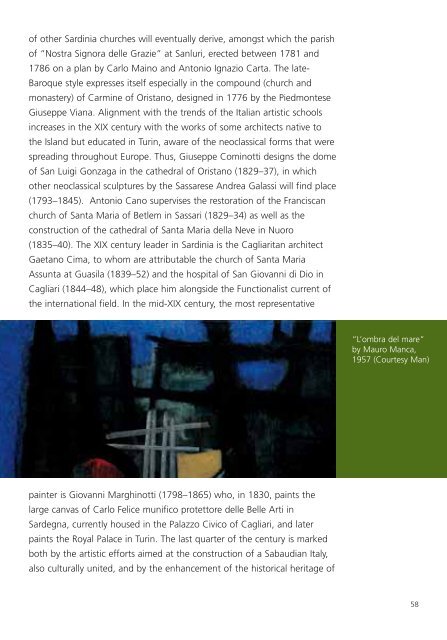You also want an ePaper? Increase the reach of your titles
YUMPU automatically turns print PDFs into web optimized ePapers that Google loves.
of other Sardinia churches will eventually derive, amongst which the parish<br />
of “Nostra Signora delle Grazie” at Sanluri, erected between 1781 and<br />
1786 on a plan by Carlo Maino and Antonio Ignazio Carta. The late-<br />
Baroque style expresses itself especially in the compound (church and<br />
monastery) of Carmine of Oristano, designed in 1776 by the Piedmontese<br />
Giuseppe Viana. Alignment with the trends of the Italian artistic schools<br />
increases in the XIX century with the works of some architects native to<br />
the Island but educated in Turin, aware of the neoclassical forms that were<br />
spreading throughout Europe. Thus, Giuseppe Cominotti designs the dome<br />
of San Luigi Gonzaga in the cathedral of Oristano (1829–37), in which<br />
other neoclassical sculptures by the Sassarese Andrea Galassi will find place<br />
(1793–1845). Antonio Cano supervises the restoration of the Franciscan<br />
church of Santa Maria of Betlem in Sassari (1829–34) as well as the<br />
construction of the cathedral of Santa Maria della Neve in Nuoro<br />
(1835–40). The XIX century leader in Sardinia is the Cagliaritan architect<br />
Gaetano Cima, to whom are attributable the church of Santa Maria<br />
Assunta at Guasila (1839–52) and the hospital of San Giovanni di Dio in<br />
Cagliari (1844–48), which place him alongside the Functionalist current of<br />
the international field. In the mid-XIX century, the most representative<br />
“L’ombra del mare”<br />
by Mauro Manca,<br />
1957 (Courtesy Man)<br />
painter is Giovanni Marghinotti (1798–1865) who, in 1830, paints the<br />
large canvas of Carlo Felice munifico protettore delle Belle Arti in<br />
Sardegna, currently housed in the Palazzo Civico of Cagliari, and later<br />
paints the Royal Palace in Turin. The last quarter of the century is marked<br />
both by the artistic efforts aimed at the construction of a Sabaudian Italy,<br />
also culturally united, and by the enhancement of the historical heritage of<br />
58
















